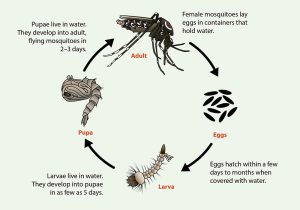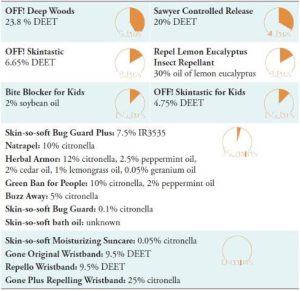UF/IFAS Mosquito Experts
I recently had the opportunity to collaborate with colleagues at the UF/IFAS Florida Medical Entomology Lab (FMEL) in Vero Beach, FL. FMEL Assistant Professors Dr. Eva Buckner, Dr. Yoosook Lee, and Dr. Lawrence Reeves are impressive experts in the field of medical entomology which is the scientific study of mosquitoes and mosquito-borne diseases. They inspired me to write this blog. Every single Floridian and visitor can play a role scouting for container mosquito habitat through community cleanups or even just scouting your own backyard.

Mosquito Larvae and Open Containers
Tires, jars, and other outdoor open containers can collect water and become habitat for mosquitoes. There is a UF/IFAS EDIS publication on Florida Container Mosquitoes that goes much more in-depth describing how water in these open containers can increase mosquito populations. The short version is it’s important to find and reduce water in open containers especially during times of heavy rainfall. Water in tires that have been improperly disposed of can be prime breeding ground for mosquitoes. Even very small water sources like a bottle cap can serve as mosquito habitat. Container mosquitoes like Aedes aegypti and Aedes. albopictus can pass some pretty nasty viruses when females take blood meals from people and domestic animals.

Credit: Credit: Centers for Disease Control (CDC).
UF/IFAS EDIS Container Mosquito Publications
I recommend taking a look at two UF/IFAS EDIS publications that describe how to reduce mosquitoes around homes and neighborhoods and how to organize a community cleanup event. There are some helpful tips that show homeowners how to reduce mosquito habitat.
- Clean out eaves and gutters.
- Drill holes in or remove old tires.
- Turn over empty plastic pots.
- Check tarps on boats and equipment for standing water.
- Pump out bilges on boats.
- Replace birdbath water once a week.
- Empty water in plant trays and hanging baskets once a week.
- Remove vegetation or obstructions in drainage ditches that prevent water flow.
- Clear out thick brush to increase airflow around the home.
The community cleanup event EDIS publication explains how to identify a target area for the cleanup and waste disposal. There is a special word in this publication about disposing of used tires. The Florida Department of Environmental Protection (FDEP) oversees all aspects used tire disposal so it is important to know their regulations as well as county regulations. Safety is a priority.
Mosquito Repellents
People can take personal responsibility to make science-based informed decisions on the use of mosquito repellents. The University of Florida’s Florida Medical Entomology Laboratory tested and published the results on the efficacy of the repellents below. Average Complete Protection Time is the time that elapses between the proper application of a repellent until the first mosquito lands on the protected area. This information is from UF/IFAS EDIS.
About “Amazing Mosquitoes”
If you have interest in learning more about being a public health entomologist, check out “Amazing Mosquitoes” by Dr. Irka Blosser and Dr. Yoosook Lee. They effectively interpret the work of a mosquito biologist from the point of view of “Ivy” as she accompanies her mom on a field trip to collect mosquitoes and learn about them. Its a book for all ages and can be purchased at Amazon and other retailers.

References
Ae. Aegypti and Ae. Albopictus Mosquitoes Lifecycle. CDC. Life Cycle of Aedes aegypti and Ae. albopictus Mosquitoes | Mosquitoes | CDC
Buckner, E., Connelly, C., Bolles, E., Culbert, D., DeValerio, J., Donahoe, M., Gabel, K., Jordi, R., McLaughlin, J., Neal, A., Scalera, S., Toro, E., and Walter, J. Mosquitoes and Their Control: Integrated Pest Management for Mosquito Reduction Around Homes and Neighborhoods. UF/IFAS EDIS. ENY-753/IN1045: Mosquitoes and their Control: Integrated Pest Management for Mosquito Reduction around Homes and Neighborhoods (ufl.edu)
Hallock, A., Buckner, E., Telg, R., and Poulin, A. Container Mosquito Habitat Community Cleanup: A How-to Guide for Event Organizations. UF/IFAS EDIS. ENY-2047/IN1286: Container Mosquito Habitat Community Cleanup: A How-To Guide for Event Organization (ufl.edu)
Lounibos, L.P., and Buckner, E.A. Florida container mosquitoes. UF/IFAS EDIS. ENY-2057/IN1315: Florida Container Mosquitoes (ufl.edu)
Mederos, L. (2021, June 22) Container mosquitoes on your property? UF/IFAS Scientists help you identify. Container mosquitoes on your property? UF/IFAS scientists help you identify – News (ufl.edu)
 1
1

